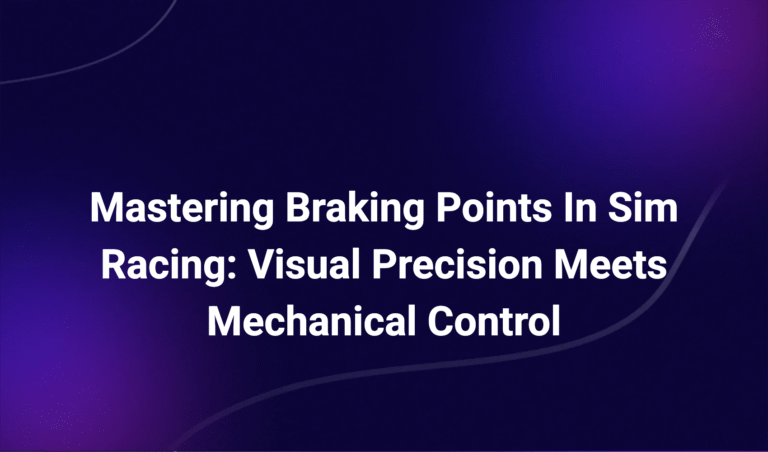Optimal Project CARS 2 Settings: Fine-Tune Your Sim for Real Driving Feel
Introduction: Don’t Let Default Settings Hold You Back
Project CARS 2 sits at the intersection of realism and accessibility. With support for a wide range of input devices, triple screens, VR, and dynamic weather, it has all the ingredients for immersive sim racing. But to experience it like a professional simulator—not an arcade game—you’ll need to reconfigure it from the ground up.
This guide will walk you through the optimal settings across all major areas:
- Field of View (FOV)
- Cockpit camera configuration
- Graphics and performance
- Force Feedback (FFB)
- VR calibration
- Controller and pedal setup
- UI and audio cleanup
1. Field of View (FOV): Set It First, or Everything Else Falls Apart
Project CARS 2 uses horizontal FOV (HFOV), and supports triple monitors and VR natively. Your default FOV will almost certainly be too wide or narrow.
How to Set FOV:
- Navigate to:
Options > Camera > Field of View - Enter the FOV value from our FOV Calculator
Approximate Ranges:
| Setup | FOV |
|---|---|
| Single 27” Monitor @ 70cm | 58–62° |
| Ultrawide 34” Monitor @ 80cm | 75–85° |
| Triple 27” Monitors @ 60cm | 90–105° |
| VR Headset | Automatically handled by headset projection |
🔍 Note: Too wide FOV = distorted depth, late braking
Too narrow = tunnel vision, poor situational awareness
2. Cockpit Camera View – Lock in Your Driver’s Perspective
Go to:
Options > Camera > Cockpit Settings
Optimal Camera Settings:
- World Movement: 0% (prevents floating perspective)
- G-Force Effects: 0–5% for slight head motion realism
- Look to Apex: 0% (do not simulate head movement)
- Camera Shake: Off
- Helmet Camera: Off (unless used with VR for realism)
Seat Position:
Adjust until:
- Steering wheel on screen matches real wheel
- Dash and mirrors are clearly visible
- Horizon is level with eye-line
This setup helps your brain anchor speed and distance without subconscious disorientation.
3. Graphics Settings – Consistent > Beautiful
Project CARS 2 is visually rich, but visual stability matters more than visual drama.
Best Settings:
| Setting | Recommendation |
|---|---|
| Resolution | Native monitor (e.g., 2560×1440) |
| Refresh Rate | Match monitor (e.g., 144Hz) |
| V-Sync | Off (unless screen tearing) |
| Texture Resolution | High |
| Shadow Detail | Medium–High |
| Reflections | Off or Low (huge performance hit) |
| Post-Processing | Low–Medium |
| Anti-Aliasing | SMAA Medium or MSAA 2x–4x |
⚠️ Dynamic Weather and Rain Effects are resource intensive. Enable only on powerful GPUs.
4. Force Feedback (FFB) – From Floaty to Responsive
Project CARS 2 includes custom FFB tuning per car and input type.
Go to:
Options > Controls > Force Feedback
Suggested Base Settings:
| Parameter | Value |
|---|---|
| Gain | 85–100% (start at 90%) |
| Volume | 50–60% |
| Tone | 50–70% (higher = more detail) |
| FX | 0–20% (adds kerb/road effects) |
Tips:
- Avoid setting Gain too high—it causes clipping and removes detail
- Use FFB Meter (enabled via dev tools) to monitor for clipping
- Customize per car using Setup > Force Feedback settings
5. VR Configuration – Fast, Focused, Fluid
Project CARS 2 supports native VR via SteamVR and Oculus.
VR Optimization Tips:
- Keep Pixel Density at 1.0 or adjust via OpenXR Toolkit
- Turn Post Processing Effects OFF for sharp visuals
- Use VR Low/Med Preset then manually increase:
- Textures: High
- Shadows: Off or Low
- Reflections: Off
- Disable Depth of Field, Motion Blur, and Bloom
- Reduce Mirrors to static or off
🧠 Pro Tip: Disable UI elements in VR—use spotter and audio cues for awareness.
6. Controls, Steering, and Pedal Input
Navigate to:
Options > Controls > Calibration
Steering Setup:
- Match your wheel’s rotation (e.g., 900°)
- Enable Soft Lock if your wheel supports it
- Set Deadzones to 0% (unless you notice signal noise)
- Turn off Speed Sensitivity for linear steering feel
Pedals:
- Calibrate throttle, brake, and clutch manually
- Use linear input curve (Gamma = 1.0)
- Disable ABS or Traction Assist unless you’re driving road cars
⚙️ Advanced Users: Use DIView or vJoy to remap or fine-tune input ranges if needed.
7. Audio and HUD Cleanup
Audio Settings:
- Engine Volume: 90–100%
- Tyre Skid: 100%
- Opponent Volume: 60–80%
- Spotter: On for practice, Off for race (can delay decisions)
HUD:
- Toggle unnecessary widgets off (e.g., map, race info)
- Keep delta, lap time, gear, and relative boxes visible
- Customize HUD scale for ultrawide or VR
Use TAB or bind a hotkey to toggle HUD modes during live sessions.
8. Advanced Settings and INI Tweaks
Edit graphicsconfigopen.xml or ffb_custom_settings.txt to:
- Disable unnecessary graphical threads
- Fine-tune FFB feel on specific hardware
- Apply triple-screen angle correction manually
- Set VR pre-rendering pipeline options
Final Thoughts: Make It Yours—But Make It Real
Project CARS 2 can behave like a true sim or a casual racer—the difference lies in your settings. When you configure it correctly, it delivers:
- Natural depth perception
- Accurate force feedback
- Realistic car behavior
- Smooth and immersive visuals
Start by using our FOV Calculator to establish a real-world scale. Then tune your camera, inputs, and UI to eliminate distractions and enhance feel.
What you’ll unlock:
- Faster lap times
- Better consistency
- Less fatigue
- More immersion
Dr. Vale’s content blends scientific precision with racer-focused clarity. Expect articles that don’t just explain the “how” but break down the “why” behind projection physics, spatial perception, and screen ergonomics in real-world terms. From triple screen angles to bezel compensation, Adrian’s work is grounded in empirical data and designed for competitive advantage.





